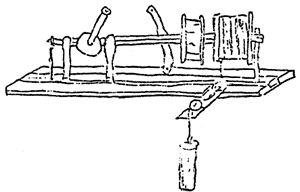Another Important Relic
By Earl U. Homuth, Ranger-Naturalist
After resting concealed among the rocks on the shore of Wizard Island for forty-six years, the sounding apparatus used in determining the depths in Crater Lake has recently been discovered. This relic, one of the most valuable and interesting which could possibly be added to the rapidly growing collection to be installed in the exhibit room of the Memorial Lookout, is on display at the Information Bureau on the Rim.
With the assistance of William G. Steel, who made the soundings in 1886, the apparatus has been reassembled. When in that year the Geological Survey sent a field party to prepare a map of the region and to sound the Lake, Mr. Steel was commissioned to have a boat constructed and to procure or build the sounding apparatus. From descriptions of such instruments Mr. Steel devised the apparatus subsequently used.
The machine consists of two wooden drums mounted upon an iron bar which was revolved by a short handle with two cog-wheels connecting to the bar. This was fastened by four iron bars to a plank forty-six inches long. The plank and drums are weathered and the iron very much rusted, and yet in remarkable state of preservation.
The drums are ten inches in diameter. One is seven inches wide and the rusted wire is still tightly wound around it. The other is four inches in width and was used as a brake to prevent the sounding weight from dropping too rapidly. The leather strap used on this drum is still attached to the plank. Two small pulleys over which the wire passed from the drum were also found. A small piece of leather may be seen attached to the wire. To facilitate the reading of the depths as they were determined, these thongs had been fastened at fifty foot intervals; at each hundred feet, up to five hundred, notches had been cut in the leather, and for each five hundred feet, holes had been punched. Actual measurements were made of the length of wire between these thongs when each depth was determined.
According to Mr. Steel, the machine was placed across the center of the Cleetwood, the boat used in the soundings. The boat was 26 feet in length and 5 feet, 10 inches beam. From the center of either side of the boat planks were fastened which were joined over the prow forming a triangular brace. On the point was placed a pulley of lignum sitae over which the wire from the machine dropped to the water.
Mr. Steel had procured ten thousand feet of wire and several window sash weights. The sash-weights were too heavy, however, and twice broke the wire carrying away sixteen hundred feet on two occasions. The weights used were cut in half and later in quarters and finally a piece of iron pipe eight inches long was used. This piece of pipe was still attached to the wire when the relic was discovered.
Mr. Steel, personally, was in charge of the soundings. The field party was under the direction of Capt. Clarence E. Dutton and Mark Kerr was Chief topographer. A group of men were detailed to the summit of the peak subsequently called The Watchman, and another group upon the eastern lakeshore. The weight was allowed to sink slowly until bottom was reached. It was then pulled up a short distance and allowed to touch bottom again. With a large flag Mr. Steel then signaled the men stationed on the shore, and they in turn drew lines upon their maps, passing on the position of the boat. In the evening these results were compared and when the lines crossed for each respective sounding the figures were entered upon the charts. Ninety-four soundings were made, the work requiring nearly one month. These are recorded upon the topographic maps used today. The greatest depth found was 1996 feet.
When the work was completed the apparatus was removed from the boat and left on Wizard Island where it has remained for forty-six years. The Cleetwood was sunk in a shallow bay of the island and the remains still lie where they were left.
Early this season the tiller and a portion of the prow were salvaged from the wreckage.
This past week Senior Naturalist and Forester Ansel F. Hall, while engaged in the work of laying out the new trail on Wizard Island, discovered the window weights which were originally used with the sounding apparatus. They were resting on the rugged lava blocks about 25 feet above the present water level. Nearby was found the wreckage of the Cleetwood, resting in a pool that is detached from the main body of the lake; the level of the lake being exceedingly low. The oar locks were found and along with the weights they will be place on display with the sounding apparatus.


